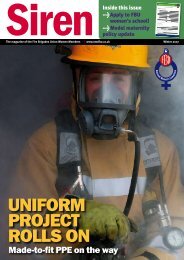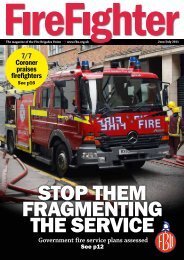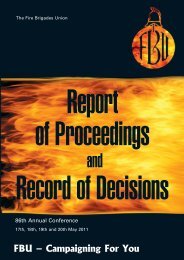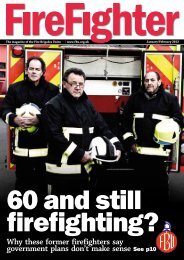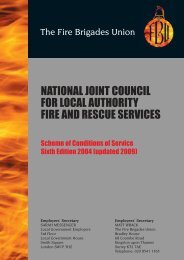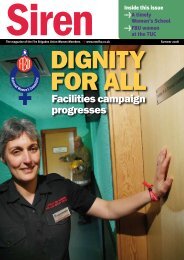Report - Fire Brigades Union
Report - Fire Brigades Union
Report - Fire Brigades Union
You also want an ePaper? Increase the reach of your titles
YUMPU automatically turns print PDFs into web optimized ePapers that Google loves.
SECTION B — FIRE AND RESCUE SERVICE POLICY<br />
Current system capabilities in business case inaccurate<br />
58) One of the main reasons cited by numerous ministers for<br />
the project was that the current systems did not support<br />
the latest technology. There were nine technology items<br />
cited in each region’s business case Part 1, being:<br />
MDTs / VMDS<br />
Information Available to <strong>Fire</strong>ground<br />
AVLS<br />
Status Updates<br />
Dynamic Mobilising<br />
EISEC<br />
GIS (Ctrl Only)<br />
GIS (Integrated into Service)<br />
Full Premise based Gazetteer.<br />
59) This information is inaccurate, misleading and has never<br />
been corrected. Some items are incorrect and others are<br />
inaccurate in that the facilities were available but the FRS<br />
chose not to purchase them e.g. Dynamic mobilising,<br />
EISEC and Premise based gazetteer.<br />
60) Ministers then used this data to cite one of the reasons for<br />
the justification for the project was ensuring all fire controls<br />
had the most up to date functions. Had the correct<br />
information been established from knowledgeable sources<br />
then this justification would have been non-existent.<br />
61) Since the project award all the items listed above are<br />
available on all the existing suppliers systems, most as<br />
standard items if local fire and rescue services judge them<br />
to be important enough to purchase them.<br />
62) The Department could have amended GD92 which sets<br />
out requirements for control systems to ensure all systems<br />
could have been gradually upgraded in the normal way to<br />
meet these requirements. They have not done so, they still<br />
could.<br />
How did we get to where we are now?<br />
63) The approach and project management were flawed from<br />
the outset. The entire project was bundled into a single<br />
contract with a prime contractor leading a consortium.<br />
Such was the scale of the project, there were probably no<br />
more than a handful of companies worldwide which could<br />
have bid for a project of this size with a realistic chance of<br />
success.<br />
64) This approach effectively meant that every existing<br />
experienced supplier of control systems to the UK fire<br />
service market eg Fortek or Remsdaq, would be excluded.<br />
They were.<br />
65) It also meant there was a very high likelihood that the<br />
prime contractor chosen would have no experience in<br />
delivering a control system to a fire service in the UK or,<br />
possibly, anywhere in the world. This is what transpired.<br />
66) Project management was supplied by a series of<br />
departments with little historical knowledge of the fire<br />
service, informed – if that is not putting it too strongly – by<br />
transient civil servants and consultants with no experience<br />
of delivering any fire service control system of any size,<br />
anywhere. It was overseen by a series of transient ministers.<br />
67) There were some FRS secondees in various numbers at<br />
various stages. Of the 60 people assigned to the project in<br />
the first few years, only 12 were from a fire service<br />
background. What weight was attached to their work,<br />
opinion or views is not known.<br />
68) Once the decision had been taken to ‘bundle’ the contract<br />
in such a way – with the inherent flaws we have outlined –<br />
the use of a consortium or prime contractor to facilitate<br />
such a large and ambitious project is entirely in order.<br />
69) However, the project differed from the fire service norm at<br />
that time in that the prime contractor (EADS) appears to<br />
have largely a supply/ install contract only. Central project<br />
management was and is being carried out by CLG using<br />
their own staff along with some seconded FRS staff and<br />
consultants.<br />
70) There were clearly major issues with the technical<br />
specifications the contractors were asked to deliver too.<br />
The project scope has been changed before, after and<br />
since the IT contract was signed. There also appeared to<br />
be no ‘real world’ assessment of the true complexity of the<br />
project nor of realistic timescales to deliver what was being<br />
demanded.<br />
71) The results are clear for everyone to see: no clear and<br />
consistent understanding of how emergency fire controls<br />
work, lack of leadership, controls, objectives and relevant<br />
technical expertise. Even with such a flawed process, a<br />
single “turnkey” contract could have removed some of the<br />
issues and led to a clear target to be achieved or penalties<br />
to be levied.<br />
72) Instead, CLG FiReControl project managers were a barrier<br />
between the contractors EADS tasked with delivering the<br />
technology and the end users –fire and rescue services.<br />
Direct collaborative working between EADS and the FRS<br />
was blocked by CLG until the creation of Solution<br />
Establishment Workshops (SEWs) in the summer of 2009.<br />
73) The central point of the creation of the SEWs is not that<br />
the process started, but that it took until the project was on<br />
its knees before CLG allowed this method of direct<br />
collaborative working to be put in place.<br />
74) Poor CLG project management was compounded by what<br />
should have been the close relationship between the<br />
FiReControl and <strong>Fire</strong>link projects. Delays to the <strong>Fire</strong>link<br />
project have had a knock-on effect on FiReControl and<br />
vice-versa.<br />
75) It is clear from our discussion with a number of those<br />
involved in both projects that there was a lack of<br />
transparency, openness and communication between the<br />
two projects for prolonged and critical periods. The<br />
responsibility for that lies heavily at departmental and<br />
ultimately ministerial level.<br />
68 FBU Annual <strong>Report</strong> 2011





